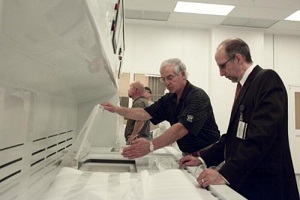Natcore achieves ‘absolute black’ silicon
 Natcore Technology scientists have achieved “absolute black” silicon solar cells.
Natcore Technology scientists have achieved “absolute black” silicon solar cells.
“If absolute zero is the complete absence of heat, then our scientists have created absolute black, the complete absence of reflected light,” according to a release from Natcore.
Absolute black silicon will increase the power output of the average solar cell by 2.5 to 3.5 percent, according to the release.
The company, which recently moved into a lab at the Kodak facility in Rochester, N.Y., uses a patented liquid phase deposition to build solar cells and will combine that technology with NREL’s black silicon.
Black silicon works to achieve greater efficiency by etching pores into the cell, reducing its reflective surface and allowing the cell to absorb more of the sun’s energy.
Natcore has been working on the National Renewable Energy Laboratory’s black silicon project for several months, said company CEO Chuck Provini. And it has seen some major breakthroughs.
Natcore was able to develop a black silicon solar cell with a reflectance of 0.3 percent.
“That’s incredible,” he said. “With the exception of NASA, no one has ever gotten a reflectance of less than 1 percent.”
NREL holds the world record for a cell made with black silicon at 18.6 percent. But the lab used cumbersome and expensive passivation technology that required thermal oxidation.
Decreasing reflectance increases power generation, Provini said. And Natcore’s goal in this partnership with NREL is to reduce solar cell costs by 2 to 3 percent while increasing power output during the day by 3 to 10 percent without using a tracking system.
Black silicon can achieve that by using an increased surface area to capture light and by reflecting less of the sun’s rays, which allows it to absorb more power on cloudy days and in the low light of early morning and late afternoon.
Provini said he hopes to have a prototype that is half black silicon and half traditional photovoltaic solar cell for NREL to lab test by the end of the month. Once the technology is tested and proven and ready for production, he said he will be looking for partners to produce it.
In further research, NREL and Natcore have agreed to spend $150,000 to develop the black silicon technology.
“Our technology will create a new American industry,” Provini said. “We’ve been trying for two years to get financial support from the Department of Energy. This is a meaningful first step.”



